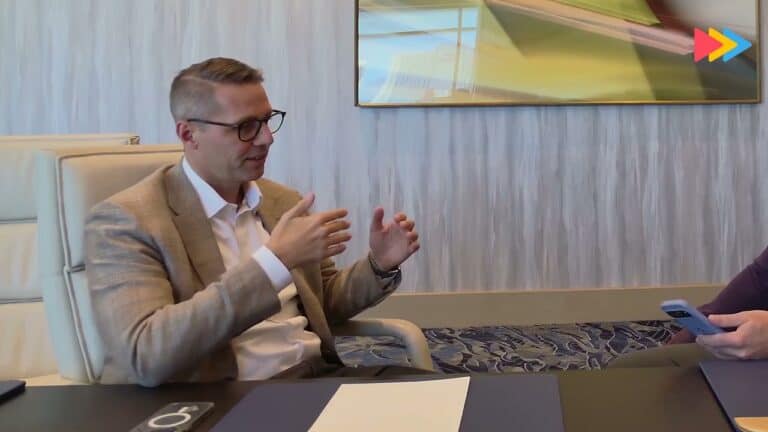SAP is leveraging AI to solve one of the biggest ERP challenges: migrating your legacy ECC ERP system to the cloud. In an exclusive interview with Techzine TV, Jan Gilg, Chief Revenue Officer at SAP, reveals how AI-powered tools are making these traditionally complex and expensive transitions faster and more affordable.
Many enterprises still rely on outdated SAP ECC systems and face significant hurdles when moving to S/4HANA cloud. Traditional migrations involve extensive manual labor, data entry work, and custom code redevelopment. These processes can span years and consume massive budgets.
“There are many customers that are still sitting on old ECC systems on-premises, and they all subscribe to the fact that they want to move to the cloud,” Gilg explains. “They want to move to the cloud with SAP, but they also ask for help to get there and cut the project time down, cut the cost down.”
RISE with SAP: more than just system conversion
SAP’s RISE program is frequently misunderstood as simply moving from ECC to S/4HANA. However, Gilg clarifies that RISE encompasses a comprehensive transformation approach including AI-infused tooling, methodology, and the clean core principles.
“RISE does include the tooling that I mentioned before. It does include a methodology, it does include the way of moving a landscape to what we call clean core, getting rid of customizations,” he notes. The program addresses the transformational aspects that often get overlooked in traditional migration discussions.
Tip: The difference between Rise with SAP and Grow with SAP
AI-Powered Migration Tools
SAP has developed an integrated toolchain that leverages AI across multiple migration phases:
Data migration: AI accelerates the process of extracting, cleaning, and optimizing data from legacy systems. This is crucial since clean data is a prerequisite for running AI applications on top of ERP systems.
Custom code refactoring: Tools like Joule for developers help analyze existing ABAP code, identify what can be eliminated, and refactor necessary extensions to be clean core compliant. The system can identify superseded capabilities, unused dead code, and valid extensions that need updating.
Architecture documentation: Through LeanIX, enterprises can visualize how their architecture will evolve in the AI era, from business suite to implementation tooling with Cloud ALM.
Clean core: the foundation for innovation
The clean core approach represents a fundamental shift toward industry-standard, fit-to-standard principles. This methodology eliminates customizations that prevent system upgrades and hinder innovation adoption.
“One of the reasons why customers often get stuck on old releases is that it’s so hard to upgrade them,” Gilg explains. Clean core compliance ensures systems are upgrade-stable, allowing SAP to update without breaking existing functionality.
Addressing implementation hurdles
Many organizations began their migrations when tooling wasn’t available, around 2015 when S/4HANA first launched. The AI revolution of the past two years has significantly improved available tools, but awareness of these advancements remains limited.
“The tooling, the integrated tool chain is nowadays in a much, much different stage than it used to be, even two or three years ago,” Gilg states. He encourages organizations that previously assessed migration difficulty to reassess with current AI-powered capabilities.
Even companies mid-migration can benefit. Large enterprises with dozens of ECC systems and rollout plans extending to 2030 are asking how to accelerate timelines to 2028, potentially saving significant costs through automation.
The future of ERP: from process to intelligence
Gilg envisions ERP evolving from process-focused systems to data and intelligence-driven platforms. “ERP processes often are commodity processes where customers then really go much, much more for a standard. And those standard processes then, of course, create very valuable data which really explains how a company runs.”
This shift will fundamentally change user interactions. Instead of logging into web screens and manually entering data, users will interact through digital assistants like Joule. The underlying ERP system remains as a system of record for compliance and consistency, but intelligent applications built on top will provide new capabilities.
Beyond ERP: Best of Suite strategy
SAP is positioning itself beyond traditional ERP boundaries, promoting a “best of suite” approach over “best of breed.” This strategy leverages integrated SAP solutions to enhance data harmonization and drive innovation opportunities across supply chain, procurement, and finance functions.
Before this is possible, customers need to move their ECC systems to S/4HANA. That means success depends on making ERP cloud migrations as efficient as possible, freeing customer budgets for broader SAP adoption and innovation initiatives.
Advice for enterprise leaders
Organizations planning or struggling with ERP migrations should reassess their approach, taking into account current AI capabilities. The combination of automated tooling, clean core methodology, and comprehensive RISE support can significantly reduce traditional migration pain points.
The investment in proper migration foundation becomes even more critical as AI capabilities mature, requiring clean, harmonized data to deliver intelligent business applications that will define the future of enterprise software.
Also read: SAP ECC and BW migration to S/4HANA can now be automated with AI
